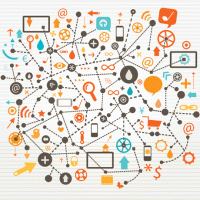The Persistent Appeal of Technology in Learning
Your content has been saved!
Go to My Saved Content.Dr. Victor Frankenstein loved technology, and Mary Shelley's work of fiction was at once a cautionary and promotional tale of technology's incredible potential. In the iconic story, he took the pieces of a human being and stitched them together to create something monstrous -- but in many ways more human than the model he was hoping to produce.
Who doesn't love a little irony?
Education loves technology, too -- and for good reason.
Education & Technology: A Sometimes Awkward Marriage
First off, people love technology, and people run education. No matter what their titles, educators and related decision-makers are human beings first, and the devices and potential that fascinate them at home also catch their eye for use in the classroom.
The same goes with students. The technology they use in their personal lives just makes sense for use in their learning as well. If a student badly wanted a new tablet or app for his or her own personal use but wanted nothing to do with it for any kind of learning whatsoever, we may need to look at the disconnect.
But there are other reasons why education consistently turns to technology -- important factors that can help us infer what it is that teachers, administrators and other stakeholders are truly after.
An educational holy grail, of sorts.
Of course, there isn’t one single holy grail because everyone sees learning differently: the role of academic learning, the function of standardized tests, the utility of having one set of common learning standards, and so on. Unlike the goals of business (profit), athletics (championships), conservation (environmental health), and other "cultural genres," in education the goal -- and thus the perfect system -- is impressively subjective.
This applies to technology as well. There's no right way to use technology any more than there's a single right way to group students or assess understanding.
But it might be interesting to pin down a few of these goals and maybe piece together the kinds of "magic" those who plan learning are looking for.
Three Goals of Technology in Education
Goal #1
Technology's Function: Reach
Education's Goal: Scale
If it does nothing else elegantly, technology provides access to everyone and everything at all times. This enables a scale impossible to achieve otherwise, from MOOCs and eLearning platforms to blended learning models that will better meet the needs of individual learners.
Goal #2
Technology's Function: Bells & Whistles
Education's Goal: Engagement & Enthusiasm
If most people are indeed drawn to technology -- and the sales numbers for tablets, smartphones, apps and televisions (to say nothing of YouTube view counts) indicate that they are -- a learning environment void of that technology is also void of the same buzz and magic they seek out when left to their own accord.
For decades, teachers have been admonished to "engage" students, and while engaging many students isn't beyond the reach of most teachers, engaging every single student every single day just might be. This is where the whir of technology can step in, flashing, pinching, zooming and beeping in familiar ways that draw students' attention -- which is exactly what it was designed to do.
Goal #3
Technology's Function: Personalization
Education's Goal: Personalized Learning
The user interface of any modern tablet or smartphone can be customized to meet the whims (or genuine learning needs) of an individual student. Apps can push notifications, real-time data can be reported, and learning algorithms can be applied to offer just in time, just enough, and just for me content, if executed properly.
Differentiation doesn't require technology, nor does fully personalized learning, but it is far more potent and accessible with it. The goal of most K-12 public education institutions -- moving every child in a classroom of 25 or more to proficiency in a common set of national standards -- can seem hopeless without it.
Waiting for the Jumpstart
So it seems, then, that education is looking for scale, enthusiasm, and personalized learning -- i.e., personalized and passion-driven learning on the widest of possible scales.
In most ways that’s probably true. But on a deeper level, it could be that education, as an industry, is continually probing all of our collective cultural tools, tricks and trades, hoping for that one tiny spark that changes everything.
That one tiny spark is going to take the standards, PLC data, research-based strategies, literacy efforts, digital media, assessments, socioeconomic realities, project-based learning, and curriculum maps -- and fuse it all into a manageable and able machine that will take off on its own, every piece functioning as it should, the entire, impossibly complex system operating as a single, well-oiled entity.
That would be Frankenstein’s monster finally jumping to life.
